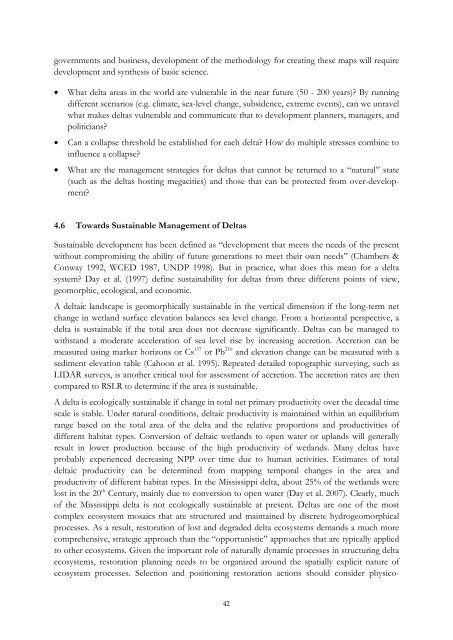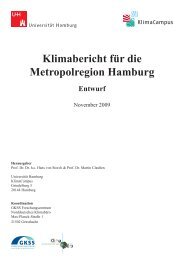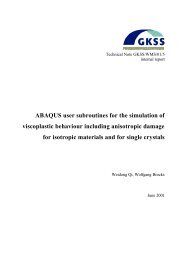Dynamics and Vulnerability of Delta Systems - loicz
Dynamics and Vulnerability of Delta Systems - loicz
Dynamics and Vulnerability of Delta Systems - loicz
Create successful ePaper yourself
Turn your PDF publications into a flip-book with our unique Google optimized e-Paper software.
governments <strong>and</strong> business, development <strong>of</strong> the methodology for creating these maps will require<br />
development <strong>and</strong> synthesis <strong>of</strong> basic science.<br />
• What delta areas in the world are vulnerable in the near future (50 - 200 years)? By running<br />
different scenarios (e.g. climate, sea-level change, subsidence, extreme events), can we unravel<br />
what makes deltas vulnerable <strong>and</strong> communicate that to development planners, managers, <strong>and</strong><br />
politicians?<br />
• Can a collapse threshold be established for each delta? How do multiple stresses combine to<br />
influence a collapse?<br />
• What are the management strategies for deltas that cannot be returned to a “natural” state<br />
(such as the deltas hosting megacities) <strong>and</strong> those that can be protected from over-development?<br />
4.6 Towards Sustainable Management <strong>of</strong> <strong>Delta</strong>s<br />
Sustainable development has been defined as “development that meets the needs <strong>of</strong> the present<br />
without compromising the ability <strong>of</strong> future generations to meet their own needs” (Chambers &<br />
Conway 1992, WCED 1987, UNDP 1998). But in practice, what does this mean for a delta<br />
system? Day et al. (1997) define sustainability for deltas from three different points <strong>of</strong> view,<br />
geomorphic, ecological, <strong>and</strong> economic.<br />
A deltaic l<strong>and</strong>scape is geomorphically sustainable in the vertical dimension if the long-term net<br />
change in wetl<strong>and</strong> surface elevation balances sea level change. From a horizontal perspective, a<br />
delta is sustainable if the total area does not decrease significantly. <strong>Delta</strong>s can be managed to<br />
withst<strong>and</strong> a moderate acceleration <strong>of</strong> sea level rise by increasing accretion. Accretion can be<br />
measured using marker horizons or Cs 137 or Pb 210 <strong>and</strong> elevation change can be measured with a<br />
sediment elevation table (Cahoon et al. 1995). Repeated detailed topographic surveying, such as<br />
LIDAR surveys, is another critical tool for assessment <strong>of</strong> accretion. The accretion rates are then<br />
compared to RSLR to determine if the area is sustainable.<br />
A delta is ecologically sustainable if change in total net primary productivity over the decadal time<br />
scale is stable. Under natural conditions, deltaic productivity is maintained within an equilibrium<br />
range based on the total area <strong>of</strong> the delta <strong>and</strong> the relative proportions <strong>and</strong> productivities <strong>of</strong><br />
different habitat types. Conversion <strong>of</strong> deltaic wetl<strong>and</strong>s to open water or upl<strong>and</strong>s will generally<br />
result in lower production because <strong>of</strong> the high productivity <strong>of</strong> wetl<strong>and</strong>s. Many deltas have<br />
probably experienced decreasing NPP over time due to human activities. Estimates <strong>of</strong> total<br />
deltaic productivity can be determined from mapping temporal changes in the area <strong>and</strong><br />
productivity <strong>of</strong> different habitat types. In the Mississippi delta, about 25% <strong>of</strong> the wetl<strong>and</strong>s were<br />
lost in the 20 th Century, mainly due to conversion to open water (Day et al. 2007). Clearly, much<br />
<strong>of</strong> the Mississippi delta is not ecologically sustainable at present. <strong>Delta</strong>s are one <strong>of</strong> the most<br />
complex ecosystem mosaics that are structured <strong>and</strong> maintained by discrete hydrogeomorphical<br />
processes. As a result, restoration <strong>of</strong> lost <strong>and</strong> degraded delta ecosystems dem<strong>and</strong>s a much more<br />
comprehensive, strategic approach than the “opportunistic” approaches that are typically applied<br />
to other ecosystems. Given the important role <strong>of</strong> naturally dynamic processes in structuring delta<br />
ecosystems, restoration planning needs to be organized around the spatially explicit nature <strong>of</strong><br />
ecosystem processes. Selection <strong>and</strong> positioning restoration actions should consider physico-<br />
42





